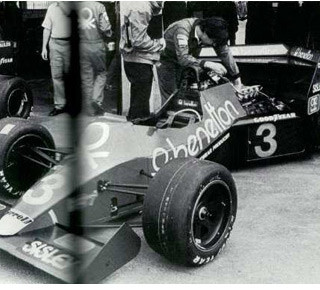Tyrrell 012-01
- Abigail Simmonds
- Jun 25, 2018
- 3 min read

Tyrrell 012-01
1983 - 1985
Designed by Maurice Philippe
Ian Simmonds Tyrrell 012-01 is currently presented in its original Benetton sponsored livery, he has owned the car since 2009 to the present.
“It was a dream to race a historic Formula 1 car, probably a foolish dream, and I’d never sat in a single-seater before getting the Tyrrell. My wife bought me a track day at Rockingham in a detuned F1 car, and I was hooked. It’s a privilege to drive the Tyrrell, a dream come true.” - (Motorsport Magazine 2016)
With ‘Ground Effects’ banned at the beginning of the 1983 season Tyrrell designer Maurice Philippe designed a completely new car for the Tyrrell team. The new car being lighter, more aerodynamic and advanced than any of its predecessor. It was the first chassis built by the team to be composed mainly of carbon fibre it was designed to be as light as possible to ensure that it would be competitive against the turbo powered Formula One cars.
Ever since 1970, the team had fitted variants of the ubiquitous Ford-Cosworth DFV 3.0L V8. The new 012 would be no different, as it would receive the DFY, a short-stroke evolution which produced 530 horsepower at 11.600 rpm, and 396 Nm, (291 lbs ft) at 9600 rpm.
Simmonds Car is the ’01’ chassis and was originally driven successfully by the Italian Driver Michele Alboreto whilst the team was sponsored by Benetton.
Debuting at the Dutch Grand Prix (Zandvoort) in 1983 the Tyrrell 012-01 finished a very credible 6th position.

In 1983 the 012-01 was the only car that Tyrrell experimented with the ‘Boomerang Wing’.
Maurice Philippe had an idea in mind about how to give the 012 an aerodynamic an advantage over its competitors, realising a conventional wing could only do so much with the maximum width given by the FIA, he set out to maximise the surface area within the available space.
As he couldn’t simply make the wing wider, he bent it into a point resembling the boomerang. In theory this was supposed to create a larger wing with more surface area, which in turn would generate more downforce without exceeding the maximum width limit. Large gurney flaps on top of the wing were intended to exploit the effect even further. He would fix the peculiar looking wing in place with large struts connecting to the sidepods, with a third example connecting to the rear differential and a smaller boomerang attaching to the rear diffuser.
Tyrrell tested the Boomerang in a short private test in England, before heading to Osterreichring (Austria) for its public test prior to the Austrian Grand Prix.
Michele Alboretto set off in his 012-01 (with Boomerang) in the first practice session. He completed a few laps with relative ease, showing the space-age wing worked at least as well as its normal winged sister.
Unfortunately a water leak ruined the session, forcing the Italian to pull into the pits. His feedback lead Philippe and Tyrrell to conclude the Boomerang wing didn’t live up to its promise, leading to Tyrrell favouring the normal wing.
In 1984, Tyrrell had lost the Benetton sponsorship. Alboretto was replaced by British driver Martin Brundle when he joined Ferrari, and Stefan Bellof joined the team to fill the seat of the second car.
The success in 1984 attracted the attention of the scrutineers and Tyrrell were accused of adding weight via lead shot in the cooling water prior to the end of the race to ensure that the car met the minimum weight requirement of 540kg. The outcome of the lengthy investigation was Brundle and team were striped of their 2nd place at Detroit.
The 012 was Tyrrells last truly competitive and consistent car and one of the last Formula One cars to run the iconic Cosworth DFV engine.
#Tyrrell012 #IanSimmonds #Tyrrell01201 #FordCosworthDFV #MauricePhilippe #BoomerangWing #MicheleAlboreto #MartinBrundle #StefanBellof #Benetton #Tyrrell #Zandvoort #Osterreichring #KenTyrrell #FormulaOne #HistoricFormulaOne #CMS #CompleteMotorsportSolutions #CMSARCHIVES #MotorsportMagazine #CourltauldsCarbonFibre #Detroit













































Comments